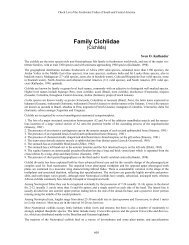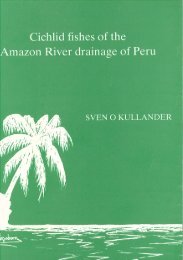Open Access PDF - Sven Kullander
Open Access PDF - Sven Kullander
Open Access PDF - Sven Kullander
Create successful ePaper yourself
Turn your PDF publications into a flip-book with our unique Google optimized e-Paper software.
two middle rows may be contiguous to some<br />
extent. Caudal ocellus dark brown, located above<br />
mid-axis, with yellow peripheral fields but not<br />
completely ocellated. Light spots absent from<br />
nape and cheeks.<br />
Specimens over 200 mm SL (Figs. 87-89) with<br />
light brown side, slightly darker dorsally. Halter<br />
stripe dark brown, extending back to jaw articulation.<br />
Preorbital stripe blackish, well expressed.<br />
Dark brown to blackish wide stripe with wide<br />
white margin from eye to opercular tip, not interrupted<br />
over preopercle. Horizontal lateral band<br />
not evident except occasionally as narrow dark<br />
brown stripe dorsally on caudal peduncle. Vertical<br />
bars faint. White spots in two horizontal rows<br />
along back, one row along abdominal side and<br />
two rows representing rows marginal to absent<br />
lateral band. Spots generally roundish and distinct<br />
except in latter rows in which spots elongate or<br />
to some extent confluent. Cheek, gill cover, and<br />
top of head with numerous white spots increasing<br />
in number and decreasing in relative size with<br />
increasing specimen length. Dorsal fin grey with<br />
two rows of white spot on spinous portion, four<br />
rows of white spots on soft portion. Anal fin<br />
whitish, shading to brownish distally. Pelvic fin<br />
brownish on lateral side, otherwise whitish.<br />
Caudal fin with round, dark brown spot, completely<br />
ringed with yellow stripe. Dorsal lobe<br />
otherwise brownish with about six rows of whitish<br />
spots; ventral lobe brownish or yellowish.<br />
Large adults, over 300 mm SL (Fig. 89), have<br />
the postorbital stripe partly fragmented and with<br />
a few additional black spots dorsally on subopercle<br />
and cheek, all with white borders. Anal fin<br />
brownish. Ocellar markings absent other than<br />
those formed by postorbital blotches and caudal<br />
spot. Specimens clearly representing breeding<br />
colour or sexual dimorphism absent in preserved<br />
material.<br />
Live and fresh preserved colours. Juvenile photographed<br />
at Rio Cadauiri yellowish with white<br />
underside and black lateral stripe.<br />
Large adults, known or estimated to be over<br />
500 mm SL apparently sexually dimorphic. Specimens<br />
probably representing males, with well<br />
developed nuchal hump, yellowish with greenish<br />
grey back and hump. Vertical bars evident, though<br />
not contrasted, light spots only indicated on side<br />
or, usually, completely absent from head, body<br />
and fins. Lower half of caudal fin, anal and pelvic<br />
fins, a band along abdominal side, branchiostegal<br />
Ichthyol. Explor. Freshwaters, Vol. 17, No. 4<br />
377<br />
membrane, and iris bright red or orange. Large<br />
specimens without hump, assumed to be females,<br />
with white spots on body, head and fins, but fins,<br />
branchiostegal membrane, side and iris red as in<br />
males. Vertical bars in those large adults proportionally<br />
wider than in young specimens; of about<br />
uniform width across side, and may appear to<br />
have slightly lighter margin, but do not form<br />
ocellar markings. Black, light-margined postorbital<br />
markings well evident and contrasted especially<br />
in large males.<br />
Geographical distribution. Restricted to blackwater<br />
rivers and their tributaries (Fig. 75), recorded<br />
from many localities along the Rio Negro<br />
in Brazil and Venezuela, many localities in the<br />
Rio Orinoco drainage, a few localities only in the<br />
Rio Branco drainage. Along the Rio Solimões-<br />
Amazonas recorded from Tefé, Rio Puraquequara,<br />
lower Rio Uatumã, Rio Preto da Eva, and Lago<br />
Saracá, all black-water habitats. Reported by<br />
Lowe-McConnell (1969) from the Rio Branco<br />
drainage in Guyana.<br />
An adult specimen from the Rio Jamari (INPA<br />
3493) and a small specimen from Lago Genipapo<br />
(INPA uncat.) on the Rio Aripuanã are questionably<br />
referred to C. temensis, but regrettably there<br />
is nearly no other Cichla material available from<br />
the Brazilian portion of the Madeira drainage to<br />
permit an understanding of the distribution of<br />
C. temensis in this region.<br />
Local names. Sarabiana (Natterer, in Heckel,<br />
1840: 413, Rio Negro); tucunaré (Natterer in Heckel,<br />
1840: 409, Boa Vista area); pintado (Schomburgk<br />
in Jardine, 1843:145, Rio Negro); Lucanari<br />
Grande (Schomburgk, in Jardine, 1843: 151, Rio<br />
Negro); tucunaré sorubiana (Magalhães, 1931:<br />
225, errata, Rio Negro); pavón pintado, pavón<br />
trucha, pavón venado (Román, 1981: 76, Venezuela);<br />
Pavón cinchado (large specimens; Román,<br />
1981: 82).<br />
Both the appelation pintado and sorubiana<br />
refer to the pimelodid catfish species Pseudoplatystoma<br />
fasciatum, known as surubi (Tupi-Guarani)<br />
or bagre pintado (Spanish).<br />
Notes. The smallest specimen (Fig. 81) was identified<br />
by the very small scales, estimated at 100<br />
in the E1 row but a precise count not possible.<br />
None of the preserved specimens show a<br />
nuchal protuberance; sport fishing web sites,<br />
however, frequently display large C. temensis,




